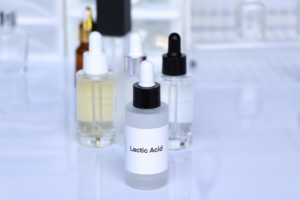
When it comes to skincare, a plethora of ingredients claim to work wonders for your skin. One such ingredient is lactic acid. It is an alpha-hydroxy acid (AHA) known for its exfoliating and skin-renewing properties. In this article, we will explore the various benefits of lactic acid for the skin, its side effects, and how to incorporate it into your skincare routine effectively.
What is Lactic Acid?
Lactic acid is a naturally occurring alpha-hydroxy acid found in milk, fruits, and vegetables. It is a water-soluble acid renowned for its gentle exfoliating properties, which promote the shedding of dead skin cells and uncover a smoother, more radiant complexion. What sets lactic acid apart from other AHAs is its mildness, making it an excellent option for all skin types, even those with sensitive skin.
“Lactic acid tends to be a more gentler exfoliant due to its molecular size, so think of it as a skin polisher,” says Dr. Lucy Chen.
When incorporated into skincare products, lactic acid can help improve skin texture, reduce the appearance of fine lines and wrinkles, and address issues like hyperpigmentation. Its ability to attract and retain moisture also aids in keeping the skin hydrated and healthy.
How Does Lactic Acid Benefit the Skin?
1) Exfoliation and Skin Renewal
Lactic acid is renowned for its gentle exfoliating properties.
“Your skin layers go through a predictable cycle of shedding every 28 days or so,” explains Dr. Chen. “The outer layers of dead skin are shed for new skin cells to come to the surface. AHAs speed up the shedding cycle by breaking down the bonds between dead skin cells, allowing them to be shed more easily.”
This process reveals a fresher, brighter, and more youthful-looking complexion. Unlike some other exfoliants, a lactic acid treatment tends to be less harsh on the skin, making it suitable for individuals with sensitive skin or those who may experience irritation with stronger exfoliating agents.
2) Hydration and Moisturization
As a humectant, lactic acid has the remarkable ability to attract and retain moisture in the skin. This helps maintain optimal hydration levels, preventing the skin from becoming dry and flaky. By locking in moisture, lactic acid contributes to a plump and supple appearance, keeping the skin soft and smooth to the touch.
“I recommend lactic acid a few times a week as part of a skin care routine for dry skin, such as rough elbows and feet,” says Dr. Chen.
3) Boosting Collagen Production
Collagen is a crucial protein that provides structure and support to the skin. As we age, collagen production naturally declines, leading to the development of fine lines and wrinkles. Lactic acid aids in stimulating collagen synthesis, helping to maintain the skin’s elasticity and firmness. This can reduce the appearance of fine lines and wrinkles, giving the skin a more youthful and rejuvenated appearance.
4) Brightening and Evening Skin Tone
Lactic acid’s exfoliating action removes dead skin cells and targets areas of hyperpigmentation and uneven skin tone. By breaking down melanin clusters and promoting cellular and cell turnover again, lactic acid helps to fade dark spots and sun damage, resulting in a more even complexion.
5) Minimizing Pore Size
Enlarged pores can concern many individuals, leading to an uneven texture and an increased likelihood of clogged pores. Lactic acid’s exfoliating effect can help to unclog pores and minimize their appearance over time, creating a smoother and more refined skin texture.
6) Balancing Oily Skin
Lactic acid can be beneficial for those with oily or acne-prone skin. Its exfoliating properties help to remove excess sebum and dead skin cells, reducing the risk of clogged pores and acne breakouts. Additionally, its moisturizing abilities prevent the skin from overcompensating with oil production, resulting in a more balanced complexion.
7) Soothing and Calming
Despite its exfoliating prowess, lactic acid is relatively gentle on the skin, making it suitable for sensitive skin types. It can help soothe and calm irritated skin, providing relief to those with conditions like rosacea or redness.
Lactic Acid for Different Skin Types
- Normal Skin: If you have normal skin, you can use lactic acid as part of your skincare routine to maintain your skin’s texture and radiance. It will provide mild exfoliation without causing excessive dryness or irritation.
- Dry Skin: Lactic acid’s hydrating properties make it an excellent choice for individuals with dry skin. It helps remove dead skin cells and allows better absorption of moisturizers, resulting in smoother and softer skin.
- Oily and Acne-Prone Skin: For those with oily and acne-prone skin, lactic acid can be beneficial in regulating oil production and preventing clogged pores. Its exfoliating action also helps in reducing acne scars and blemishes.
How to Use Lactic Acid in Your Skincare Routine?

1) Patch Test First
Before incorporating lactic acid into your routine, it’s essential to perform a patch test to check for any adverse reactions.
2) Start with Low Concentrations
If you’re new to lactic acid, start with products containing lactic acid safely lower concentrations (around 5-8%) to allow your skin to acclimate gradually.
3) Frequency of Use
Use lactic acid once a week and gradually increase the frequency to 2-3 times a week, depending on your skin’s tolerance.
4) Follow with Sunscreen
Lactic acid can increase skin sensitivity to the sun. Always apply sunscreen with adequate SPF during the daytime.
Possible Side Effects of Lactic Acid
Skin Irritation
Some individuals may experience mild redness, itching, or irritation when using lactic acid. If this occurs, reduce the frequency of use or discontinue the lactic acid product used altogether.
Photosensitivity
As mentioned earlier, lactic acid can make the skin more sensitive to the sun’s rays. Therefore, wearing sunscreen and protective clothing when exposed to sunlight is crucial against skin cancer.
Allergic Reactions
While rare, some people may be allergic to some lactic acid products. If you notice any signs of an allergic reaction, such as swelling or hives, stop using the product and consult a dermatologist.
Combining Lactic Acid with Other Skincare Ingredients
Lactic Acid and Retinol
It is generally safe to use lactic acid and retinol together. However, if you have sensitive skin, it’s best to use them on alternate nights over the counter to avoid over-exfoliation.
Lactic Acid and Vitamin C
Combining lactic acid with vitamin C can enhance the brightening and anti-aging effects on the skin. Use them at different times of the day to prevent any potential interactions.
Lactic Acid and Niacinamide
Lactic acid can complement the effects of niacinamide in improving skin texture and reducing the appearance of enlarged pores.
Fast Facts
| Definition | Lactic Acid is an alpha hydroxy acid (AHA) derived from milk. It is a water-soluble exfoliant. |
| Cosmetic Use | Commonly used in skin care products for chemical exfoliation, improving skin texture and tone. |
| Impact on Skin Types | Suitable for most skin types, including dry, normal, oily, and combination. It can be sensitive skin-friendly, but a patch test is recommended. |
| Potential Benefits | Exfoliates dead skin cells, It helps to improve skin texture and tone, Reduces the appearance of fine lines and wrinkles, Can promote collagen production and Aids in treating hyperpigmentation and dark spots. |
| Drawbacks | It may cause irritation or redness if used too frequently or at high concentrations and it can increase sensitivity to the sun, so sunscreen is essential |
| Recommended Usage | Start with 1-2 times per week and gradually increase to 3-4 times per week, depending on tolerance. |
| Compatibility with | Often combined with other AHAs (e.g., glycolic acid) for enhanced effects |
| Other Ingredients: | Can be used with hydrating ingredients like hyaluronic acid |
| Precautions/Recommend | Patch test before using on the entire face, Avoid using on broken or irritated skin and Always wear sunscreen during the day |
| Who Should Use | Individuals seeking skin exfoliation and improvements in texture and tone. |
| How Often to Use | 1-4 times per week, depending on individual tolerance and product strength. |
| Works Well With | Hyaluronic acid, niacinamide, peptides, and other hydrating and soothing ingredients. |
| Don’t Use With | Strong retinoids, benzoyl peroxide, or other harsh exfoliants. |
Frequently Asked Questions (FAQs)
Q1: Is lactic acid suitable for sensitive skin?
Lactic acid is generally well-tolerated by sensitive skin types. However, starting with lower concentrations and performing a patch test before regular use is essential.
Q2: Can lactic acid help with dark spots?
Yes, lactic acid’s exfoliating properties can help fade dark spots and hyperpigmentation.
Q3: What time of day should lactic acid be used?
Lactic acid can be used both in the morning and evening skincare routines. If using it during the daytime, remember to apply sunscreen afterward.
Q4: Can I use lactic acid during pregnancy?
It is best to consult with a healthcare professional before using lactic acid or any other active skincare ingredient during pregnancy.
Q5: Should lactic acid be used before or after cleansing?
Lactic acid is usually applied after cleansing and moisturizing to ensure better absorption and efficacy.
Conclusion
Incorporating lactic acid into your skincare routine can improve your skin’s texture, hydration, and overall appearance. However, it’s essential to use it cautiously, especially if you have sensitive skin. Start with lower concentrations, and always wear sunscreen when using lactic acid during the day.
As with any new skincare product, consider performing a patch test before regular use. If used wisely, lactic acid can be valuable to your quest for healthy and radiant skin.


